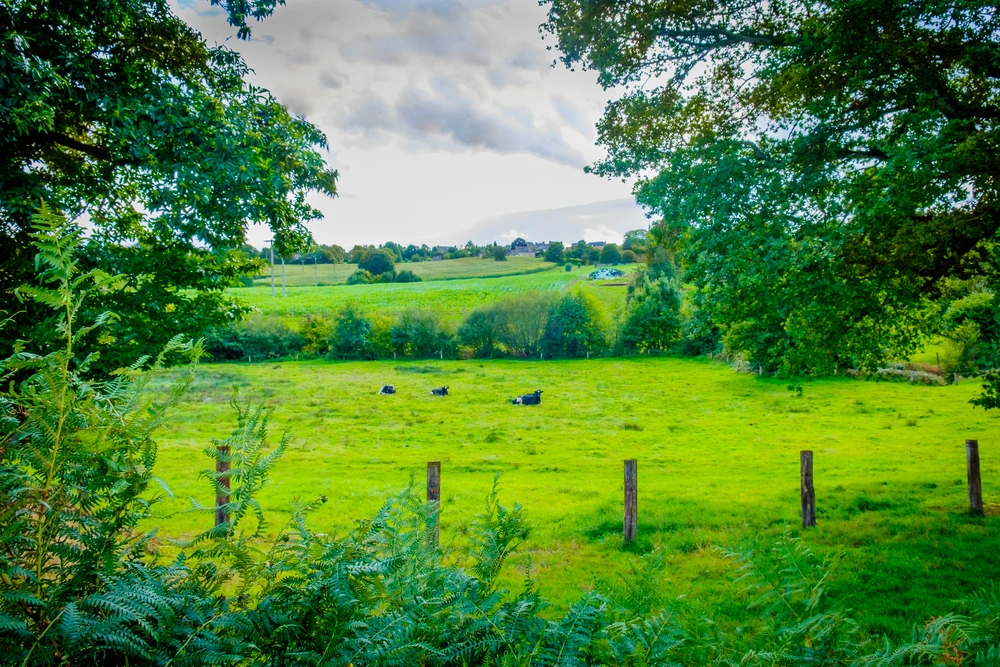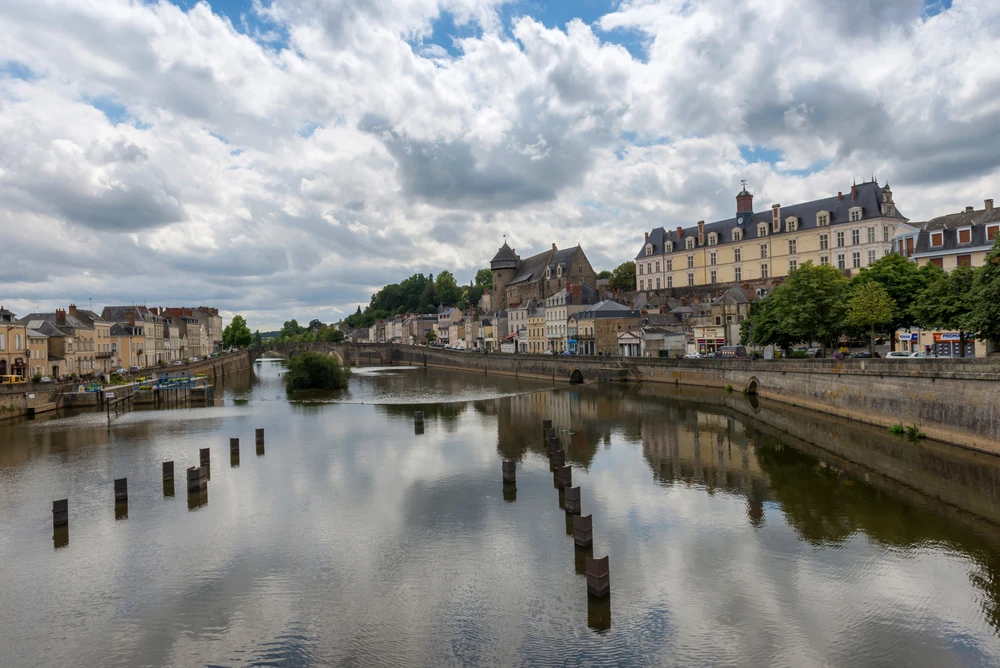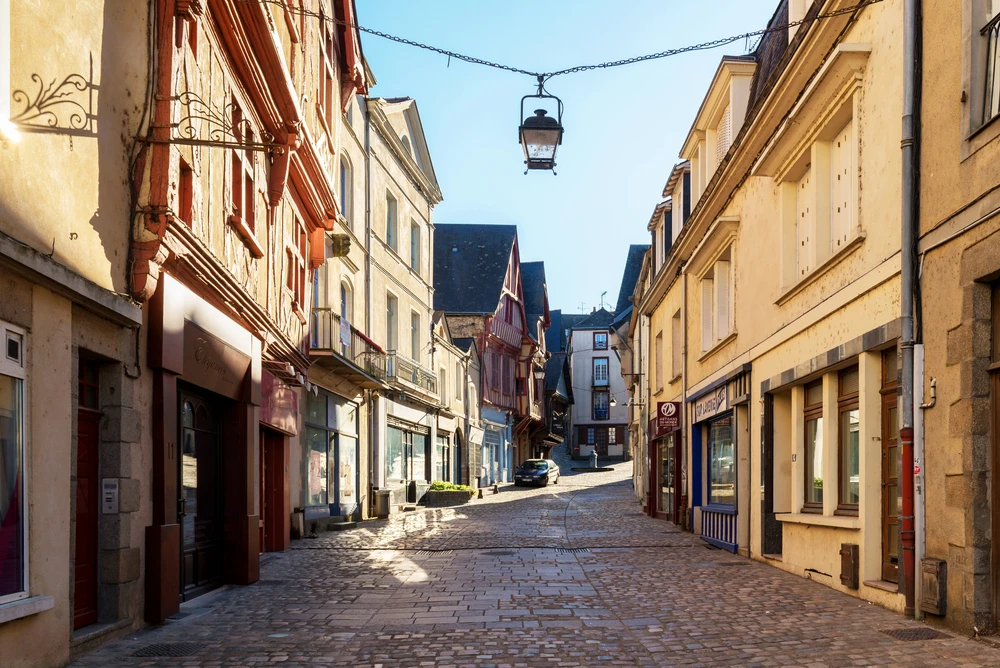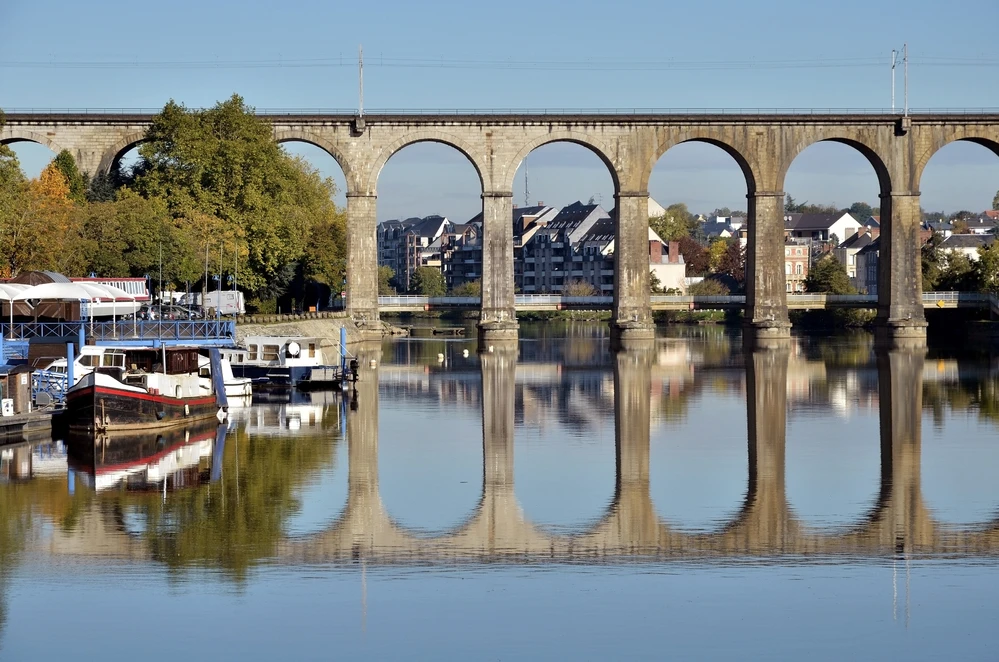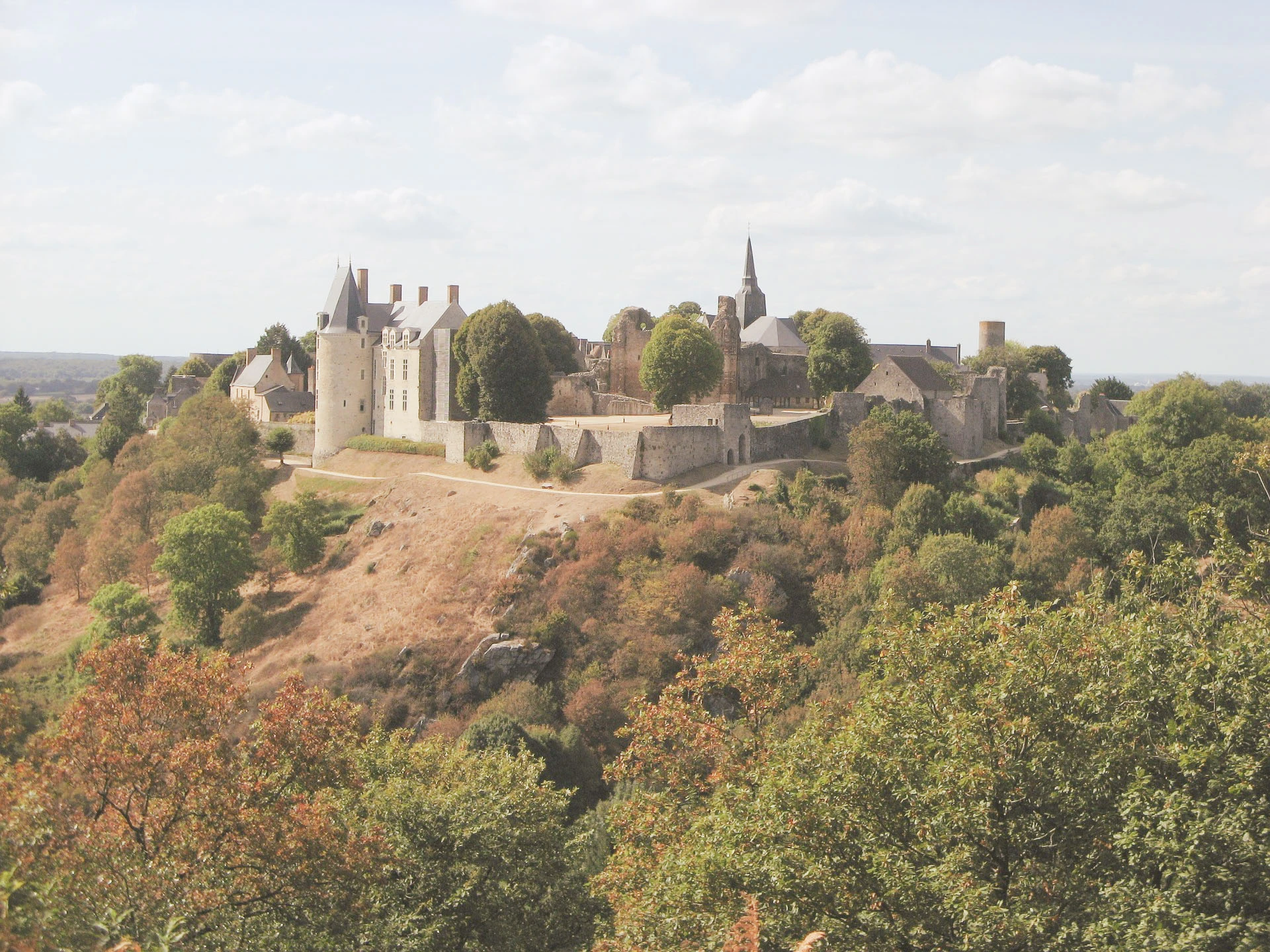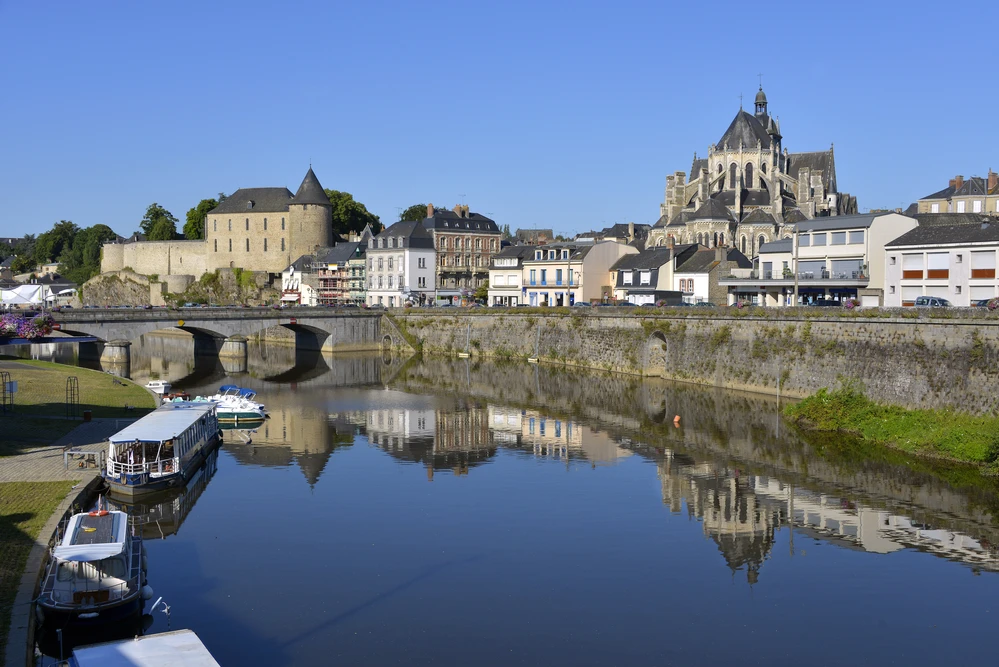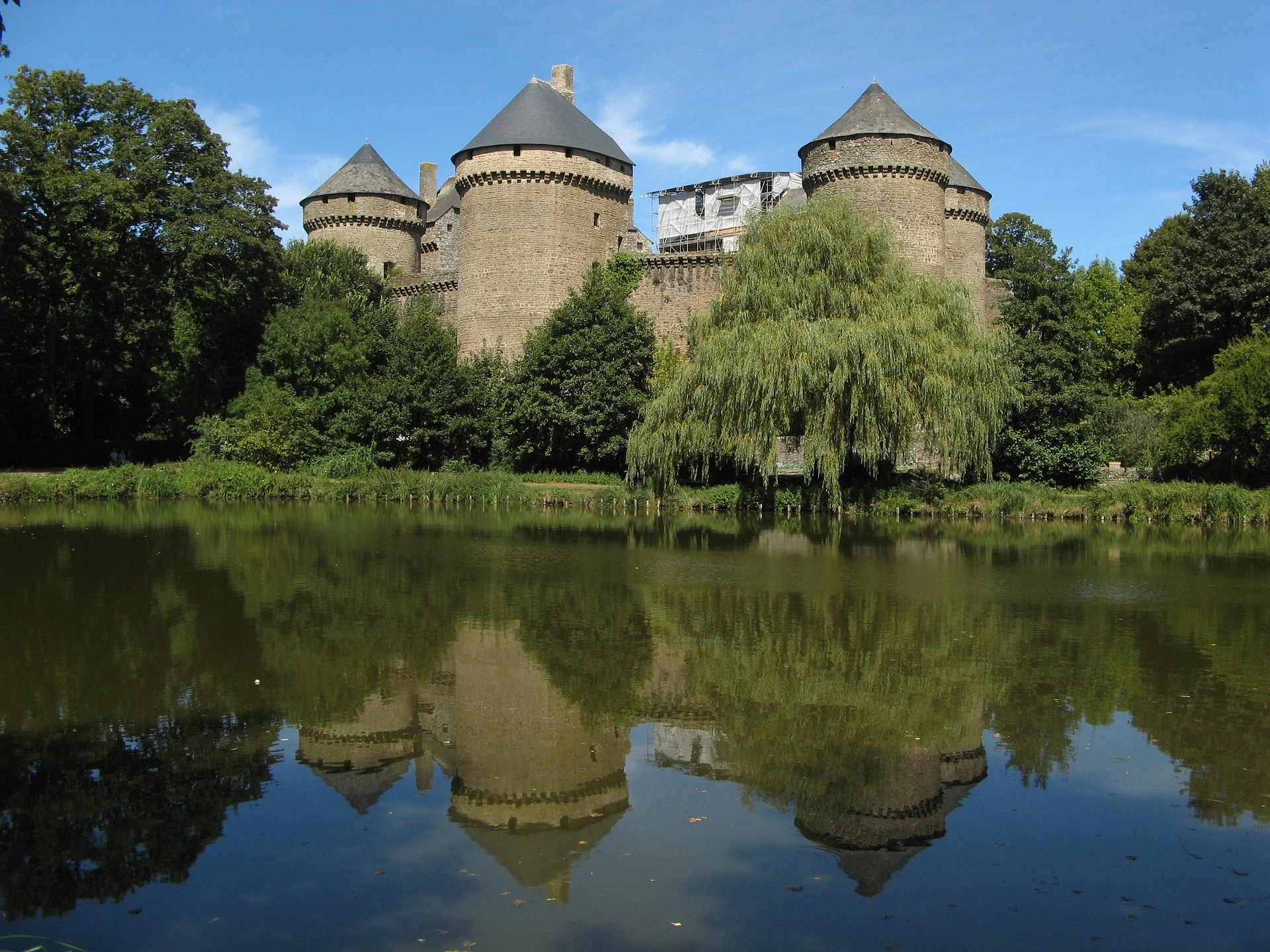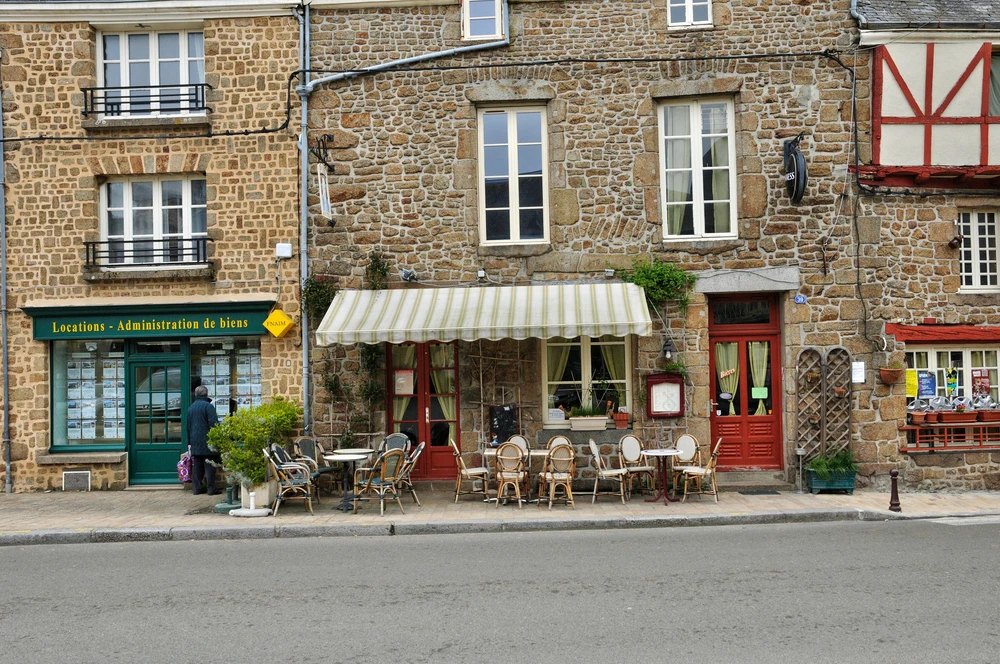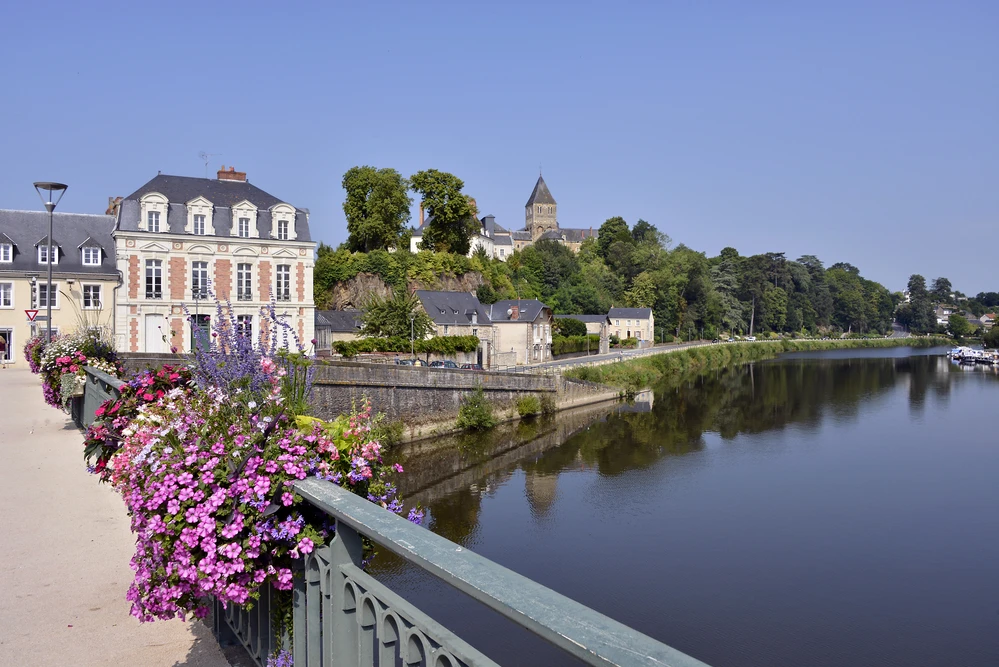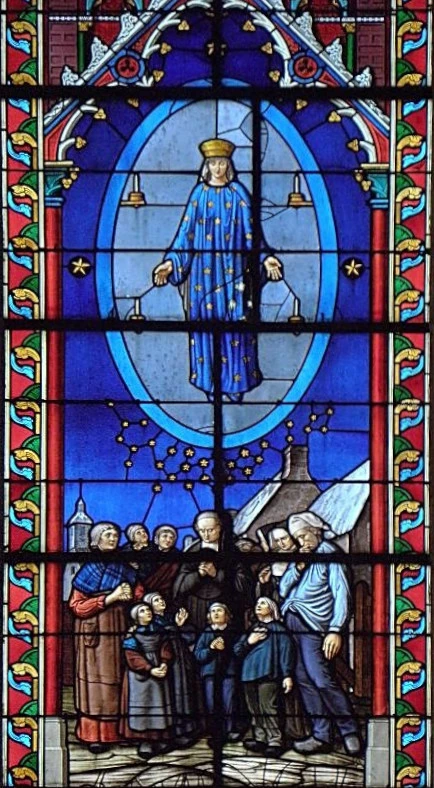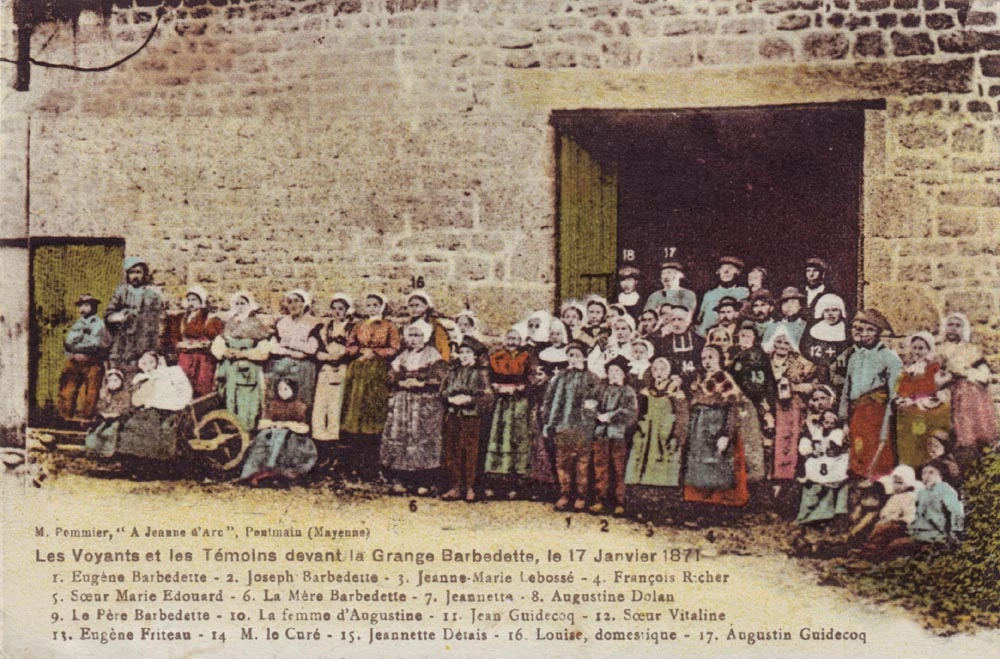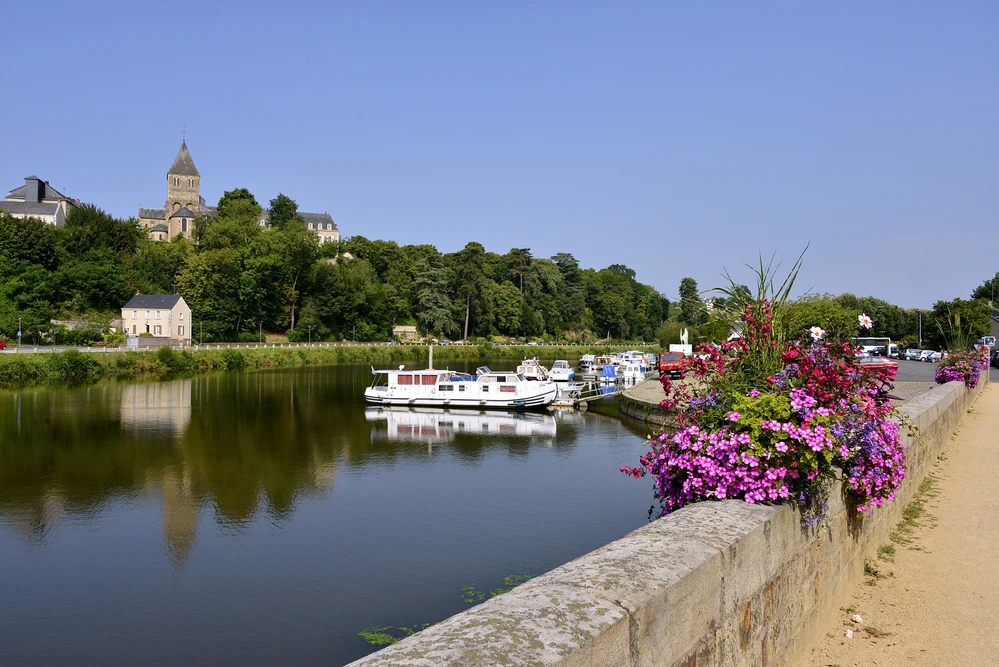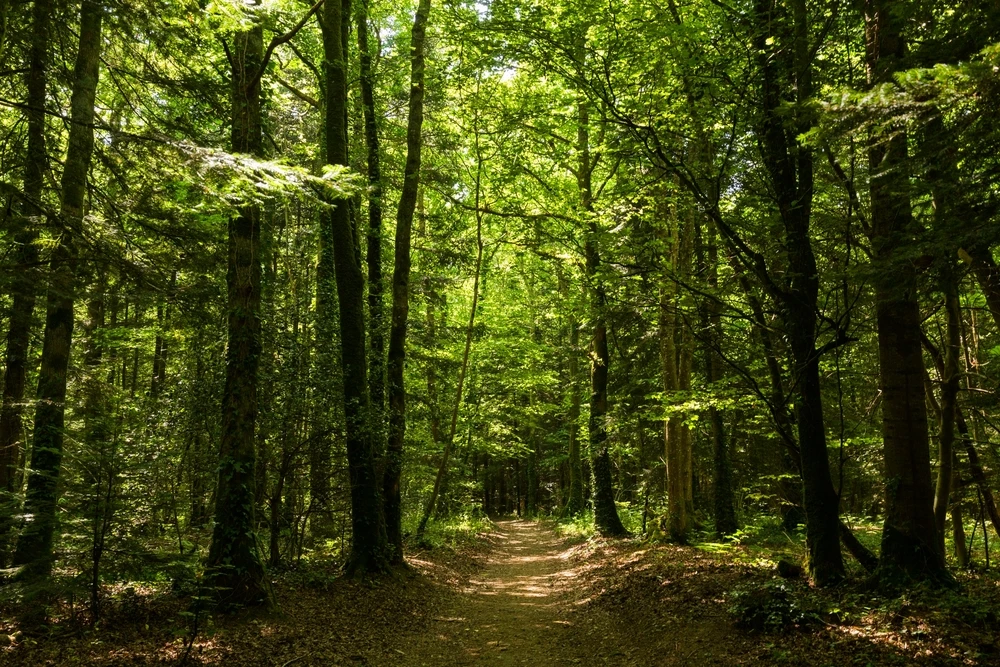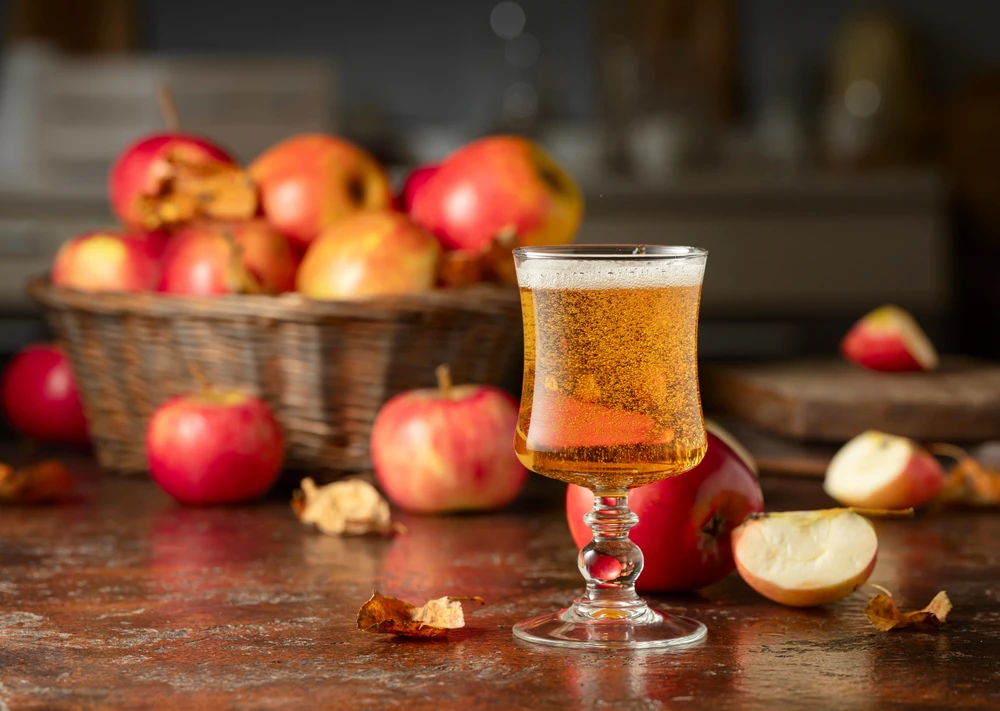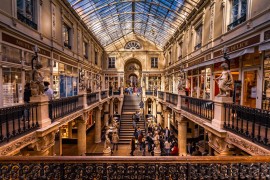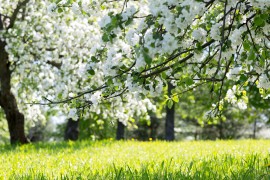The "Picture-Perfect" France You’ve Been Looking For
Mayenne has a population of just over 300,000 and three main towns: Laval (around 50,000 inhabitants), Mayenne, and Château-Gontier. All three are located on the banks of the river that gave its name to the department created in 1790. The river flows 202 km from Mont des Avaloirs (the highest point in western France at 417 meters above sea level) before joining the Maine River in Angers. A department dotted with small, very dynamic towns such as Ernée, Craon (with its superb 18th-century castle), Evron, Gorron, Ambrières-les-Vallées and Pré-en-Pail. A land of fine food, of course, where you can sample the famous rillettes (from Gorron: the best!), entrecôtes (in Evron), apples in all their forms (thanks to the orchards of the Bocage), including cider and pommeau, and a good selection of river fish, thanks in particular to the Mayenne River, which is the backbone of this department where green offers an incredible palette of colors. Bright and clear in spring, deeper in summer, in the hedgerows that line the roads of the north, and in the fields with grass that alone justifies the Mayenne being the department of horses and livestock. A "picture-postcard" department that offers you, around its many bends, typical villages with a church, town hall, war memorial, and café. Very often, a castle is not far from the village. It must be said that there are many of them here, often inhabited by the same family for a very long time. This is a destination to consider if you like greenery and relaxing while listening to the crickets, far from the major tourist sites but never too far from the main roads or major cities. A delightful place, close to nothing... but not far from everything!
Where is Mayenne?
Located in the Pays de la Loire region, it occupies a strategic position between Rennes and Le Mans.
-
Access: Laval is 1 hour and 10 minutes from Paris by TGV (12 trips per day) and 3 hours by car via the A11. Rennes is 45 minutes away, as are Angers and Le Mans.
-
Key cities: Laval (the prefecture), Mayenne, and Château-Gontier, all three of which are bathed by the river that gives the department its name.
Greenery is the hallmark of the Mayenne department. Photo selected by monsieurdefrance.com: frederiquewacquier via Depositphotos.com
My Top 10 Must-See Attractions in Mayenne
1 Laval: The capital by the water
It is the "capital" since it is the prefecture of the Mayenne department. A beautiful city of around 50,000 inhabitants that stretches along the river, which takes its time to cross it, offering a few thrills as it passes through the locks. A river with character. Its height and color change depending on the weather, which gives it plenty of reasons to be unpredictable. There's nothing more pleasant than walking along or crossing the river, for example on the 13th-century "Pont Vieux" (Old Bridge) (it's solid!). You can also enjoy a drink on its banks in summer at the Halte Fluviale (which also rents electric boats if you want to play at being sailors).
Laval seen from the Mayenne River. In front: the old bridge, which dates back to the Middle Ages; on the right, the "old castle" with its circular keep and the "new castle" with its lighter-colored facade. Photo selected by monsieurdefrance.com: Depositphotos.com
Things to see in Laval: the castles. There are two of them: the "old castle" and the "new castle." The two are very close to each other and even somewhat intertwined, since when arriving from the (pretty) Place de la Trémoille, you can enter both buildings. The old castle dates back to the Middle Ages and is notable for its rare circular keep, still topped with "hours" (battlements) which were used to hurl all sorts of unpleasant things at attackers. Next to it, the new castle, which was long used as the town's courthouse, is more delicate, with its 16th-century windows and carved doors. They are open to visitors (there is also a museum of Naïve Art). Around the castles, Place du 11 Novembre (the heart of the city), shopping streets, and small streets lead from the river up to the castles and the cathedral. Rue de la Trinité, for example, has pretty half-timbered houses. There are also beautiful mansions (the Hôtel du Plessis d'Argentré is remarkable) and the Science Museum building is worth a visit (not only for its collections, but also for its typical facade, which looks like something straight out of an American fantasy film).
Trinity Street. Typical of the charming little streets around the cathedral and castle, which you can walk up from the riverbanks. Photo chosen by monsieurdefrance.Com: depositphotos.com
Laval has been the birthplace of many talented individuals: Ambroise Paré (c. 1509-1590), before becoming the personal surgeon to the kings of France and inventing arterial ligation, was born here and learned the basics as a barber (hairdresser!) and therefore surgeon (in the Middle Ages, barbers also performed medical procedures such as bloodletting). Alfred Jarry (1773-1907), the father of "Ubu Roi," was born here. So was Alain Gerbault (1893-1941), navigator and explorer. A man with an incredible destiny, he was a pilot during the First World War and became famous for flying solo around the world in 1929. Among other anecdotes from a life full of twists and turns, he was one of the rare reasons for the Davis Cup to be interrupted when he arrived unexpectedly to cheer on the French team (he was a renowned tennis player himself). Laval has, unintentionally, become a breeding ground for artists in the "Naïve Art" movement, foremost among them: Le Douanier Rousseau (1844-1910) and his paintings, then Robert Tatin (1902-1983) and his sculptures (which can be seen at the Musée Tatin in Cossé-le-Vivien, as we shall see). If you like art, you will want to visit the MANAS (in the Château), which specializes in Naïve Art, and the Museum of Fine Arts.
L'étonnant viaduc qui surplombe la cité et la rivière. Sur le côté de la rivière la halte fluviale où je vous conseille de boire un verre. Photo choisie par monsieurdefrance.com : depositphotos.com
Finally, Laval is a sporting city, particularly when it comes to soccer. The famous Stade Lavallois club brought glory to the city in the 1980s and continues to be the pride of the city at the Francis Le Basser stadium. It is part of the identity of the people of Mayenne, along with the local radio station France Bleu Mayenne, long known as Radio Mayenne and the oldest local station of Radio France. In short, here we cheer on the Tangos (named after the orange color of their jerseys).
-
Don't miss: Rue de la Trinité and its half-timbered houses, as well as the MANAS (Museum of Naïve Art), a tribute to local talents such as Le Douanier Rousseau.
-
My advice: Have a drink at the river stop while admiring the Viaduct at sunset.
Practical information:
- Laval is 3 hours from Paris by car via the A11.
- The Laval TGV station offers 12 round trips per day to the capital. It is 45 minutes from Rennes, and the same distance from Angers and Le Mans.
- Discover the Laval Agglomeration tourist office website.
- Discover the Mayenne tourism website.
2. Sainte-Suzanne: The perched pearl
A magnificent village with its castle. A real favorite that we couldn't forget to show you. Sainte Suzanne is a village with a population of just over 800. The village is perched high on a hill. It is mainly built of white stone, which gives it different shades depending on the mood of the sun. This elevated position, allowing it to dominate the surrounding area and see trouble coming, explains the presence of an important fortified castle in the Middle Ages (it was notably besieged by William the Conqueror). In the middle of the Middle Ages, it had no fewer than 11 towers. Almost ruined in the 16th century, the castle was rebuilt in the style of Henry IV by its new owner, Guillaume Fouquet de la Ravenne, in 1608. He gave it the appearance we still see today, incorporating one of the towers into the new buildings. A historic monument since 1861, it was partially restored in 1969 to become an arts center and has been owned by the Department of Mayenne since 1998.
The village of Sainte Suzanne seen from Tertre Ganne. Image selected by monsieurdefrance.com: Image by baccus7 from Pixabay.
There is more to Sainte Suzanne than just the castle. You can lose yourself in the narrow streets. The Sainte Suzanne church in Sainte Suzanne is worth a visit, particularly for its slate bell tower. There are some lovely walks to be had around the town, notably in Clairbois, which has reconstructed a medieval camp, or near the Tertre Ganne, which offers some magnificent photo opportunities. In the countryside, you will come across the Erves dolmen, which is over 5,000 years old and is the oldest monument in Mayenne.
-
History: It is the only city that resisted William the Conqueror!
-
The site: Explore the castle, lose yourself in the narrow streets, and walk up to Tertre Ganne for a breathtaking view of the fortress.
Practical information:
- The GPS address of the castle is 1 Rue Fouquet de la Varenne, 53270 Sainte-Suzanne-et-Chammes.
- Laval is located 43 km (38 minutes by car) away. Paris is 2 hours and 37 minutes away via the A11. There is no train station.
- Discover the tourist office website (very well done)
- Discover the Mayenne tourism website.
3. Mayenne: The city of dukes
Mayenne with the river, the castle, and the Basilica of Notre-Dame des Vertus. Photo selected by monsieurdefrance.com: Christian via depositphotos
It is the town of Mayenne, on the banks of the Mayenne River, in the department of ... Mayenne. It's simple! A town with just under 13,000 inhabitants that offers a pretty town center around the river and at the foot of a castle, as in Laval. Most of the castle, particularly the keep, dates back to the 13th century. The town gave its name to an important family, whose most prominent member was Duke Charles de Mayenne (1554-1611), one of the leaders of the League and an enemy of the French kings Henry III and Henry IV before finally rallying to the throne. There are some beautiful mansions in the town, such as the Hôtel Montpinçon and the Hôtel Chappedelaine with its pretty turret. Also worth seeing are the Basilica of Notre Dame des Miracles and, above all, the pretty and discreet Church of Saint Martin, one of whose facades is 1,000 years old. The countryside around Mayenne is magnificent, a deep green. You can also visit the site of Jublains(20 km away), which was the ancient city of Noviodunum and had several thousand inhabitants in Gallo-Roman times. Much remains, such as the surrounding wall and the thermal baths (in the church), and you can visit the Jublains Archaeological Museum.
Nearby: Don't miss the site of Jublains, an ancient Gallo-Roman city with an incredibly well-preserved theater and temple.
Practical information:
- Laval is located 33 km (25 minutes by car) away. Paris is 3 hours and 12 minutes (286 km) away via the A11. It takes just under 4 hours via the N12.
- The Mayenne train station is located on Place Gambetta.
- Discover the Haute-Mayenne Valley tourist office website
- Discover the Mayenne tourism website.
4. Lassay-les-Châteaux: The Middle Ages in full scale
It is honestly one of the most beautiful villages in France. It is full of treasures such as the rose garden (magnificent, created by a landscape gardener in 1993) – it must be said that Lassay is a village in bloom – a medieval garden, wash houses, charming little streets, and several castles. The best known is the fortified castle, which the Montalembert family does everything in its power to maintain. An impressive castle straight out of the Middle Ages. The most important part dates from the 14th century, but its roots go back to the 12th century. With its towers and keep, it is still equipped as if it were about to withstand a siege with a drawbridge, a barbican (to slow down the arrival of attackers at the gate) and the towers are still topped and could allow the besieged to throw quite a few nasty things from the machicolations.
The fortified castle of Lassay les Châteaux. Photo selected by monsieurdefrance.com: by baccus7 from Pixabay.
Lassay is also home to the Château du Bois-Thibault, a partially ruined, highly romantic and inspiring castle. Speaking of inspiration, Victor Hugo himself visited Lassay. He even drew a sketch of the castle. The town is linked to many famous figures, notably the family of the Marquises of Lassay, one of whose members was renowned under Louis XIV for being an inveterate womanizer. He is even said to have inspired Don Juan. His son, Léon de Mardaillan, Marquis de Lassay, had a sumptuous mansion built in Paris. It became the residence of the President of the National Assembly (and one of the best wine cellars in the capital). Also noteworthy is the astonishing Jean Baptiste Volcler (c. 1760-1813), who was vicar (assistant to the parish priest) of Lassay before becoming its mayor during the French Revolution. A staunch revolutionary, he had many people guillotined and would have done worse if he had been allowed to continue, to the point that he was put on trial after the Revolution. He was careful not to insist on this trial, ending his days in Abbeville in the Somme region as the owner of an inn and a family man.
Facades in the village of Lassay Les Châteaux. Photo selected by monsieurdefrance.com: packshot / deposithotos.com
Practical information:
- Lassay is located 50 km (40 minutes by car) away. Paris is 3.5 hours (304 km) away via the A11 highway. It takes 4 hours via the N12 highway.
- There is no train station.
- Discover the official website of Château de Lassay les Châteaux.
- Discover the tourism office website
- Discover the Mayenne tourism website.
5. Château-Gontier: The elegance of the South
A town of around 16,000 Castrogontériens (not easy, eh!). It takes its name from a certain Gontier who owned a castle there in the 11th century. Interestingly, during the French Revolution, its name was considered too aristocratic because it included the word "château," so the town became Mont-Hardi. It is a truly beautiful town, located on the banks of the Mayenne River and literally dotted with monuments, each one prettier than the last. Among other things, don't miss the 15 historic monuments in Château Gontier (the locals sometimes call it Chio for short). You can explore the remains of the castle, the churches of Saint Jean Baptiste and La Trinité, and numerous mansions, including the Hôtel du Tertre de Sancé, the Hôtel de Lantivy, the Hôtel de Saint Luc, and the Manoir de Monviant. We are already in Anjou, specifically in Haut-Anjou, which explains the light-colored stones.
Château Gontier seen from the Mayenne River. Image selected by monsieurdefrance.com: Christian via depositphotos.
Practical information:
- Château Gontier sur Mayenne is located 31 km from Laval (40 minutes by car). Paris is 3.5 hours away (285 km) via the A11.
- The train station is located at 12 Avenue de la Gare (but please note that tickets are sold at 12 Avenue du Maréchal Joffre).
- Discover the website of the South Mayenne Tourist Office.
- Discover the Mayenne tourism website.
6. The Robert Tatin Museum: Monumental Imagination
Painter, sculptor, and ceramist Robert Tatin (1902-1983) was a leading figure in the Naïve Art movement. He created a world of his own that never fails to intrigue and captivate. It was in Cossé-le-Vivien, at a place called "La Frenouse," that he installed an "art environment." This monumental work became a museum with the approval of André Malraux, who inaugurated it himself in 1969. The Robert Tatin Museum attracts more than 30,000 visitors each year.
Practical information:
- Cossé le Vivien is located 20 km from Laval (20 minutes by car). Paris is 3.5 hours away (304 km) via the A11. 4 hours via the N12.
- Discover the Mayenne tourism website.
7. Pontmain: The Little Lourdes of the West
The blue hues are magnificent in the Basilica of Notre Dame de Pontmain. Photo selected by monsieurdefrance.com: FranckA123 via depositphotos.com
It is the smallest of France's major Marian shrines: Pontmain is a very important place for Catholic Christians, as the Virgin Mary is said to have appeared there on January 17, 1871, during the night. The Barbedette children, who were pounding gorse for livestock in a barn, went outside and saw a "great lady" above the house opposite. Dressed in a blue dress studded with stars and wearing a crown, she remained there for a moment and delivered this message: "But pray, my children, God will answer your prayers soon. My son is letting himself be touched." In the Mayenne countryside, there are many calvaries with red crosses, like those that accompanied the Virgin Mary in Pontmain. This religious site is officially recognized by the Church, just like the great center of Lourdes.
Our Lady of Pontmain depicted on one of the basilica's stained glass windows. Photo selected by monsieurdefrance.com: FERNANDES Gilbert via wikicommons.
Places to visit in the village include the Basilica of Our Lady of Pontmain, built in 1874 on the spot where the Virgin Mary appeared. It is magnificent, painted in shades of blue. Not far away is the Church of Saint Simon and Saint Jude, which dates back to the Middle Ages, although it was renovated in the 18th century. It has the atmosphere of a typical small country church, which contrasts with the large size of the nearby basilica. Also worth seeing is the Barbedette barn, where the children were at the time of the visions. Finally, the Pontmain Contemporary Art Center is well worth a visit. The same goes for the countryside, with its hedgerows and the surrounding villages: Landivy, Fougerolles or, further away in the Manche department, the ruins of Savigny le Vieux Abbey.
The inhabitants of Pontmain in 1871, including children in the front row, testified to having seen the Virgin Mary on the night of January 17, 1871. Old postcard. Public domain / Wikipedia.
Practical information:
- Pontmain is located 55 km from Laval (48 minutes by car). Paris is 3 hours and 40 minutes away (325 km) via the A11 and A81 highways.
- The official website of the Pontmain Shrine.
- Discover the Mayenne tourism website.
8. The towpath: 85 km of freedom
It literally follows the Mayenne River, which makes sense since it was used to "haul" barges with horses connected by cables that walked along the path beside the river to pull the barges. This "walking path" has been preserved from that era and has become one of the most beautiful greenways in France, stretching 85 km and offering superb discoveries. You can walk along the river, enjoy the natural surroundings, and often come across castles. You can also rent barges to cruise along the Mayenne River. It's a real change of scenery.
The towpath passes through Château-Gontier. There are barges available for hire. Photo selected by monsieurdefrance.com Christian via depositphotos.com
Practical information:
- The towpath can be accessed from many locations, but feel free to visit this website.
- A houseboat rental site on the Mayenne River
- Discover the Mayenne tourism website.
9. The Saulges Caves: A leap into prehistory
This is a group of several caves (Grotte Coudreuse, Grotte de Rochefort, Grotte de la Chèvre, Grotte de la Baleine itself!) that are located more or less near the Erdre River. They were inhabited in prehistoric times,more than 25,000 years ago, as numerous excavations have shown. There are also caves in other nearby towns, such as "La Cropte" (which means "cave" in Old French). A museum allows visitors to explore some of them. An amazing site.
Practical information:
- Saulges is located 40 km from Laval (30 minutes by car). Paris is 3 hours away (250 km) via the A11 and A81 highways.
- The official website of the Saulges caves
- Discover the Mayenne tourism website.
10. Le Mont des Avaloirs: The roof of the West
Mont des Avaloirs is the highest point in western France (all the way to Brest! The west is huge). It rises to a height of 417 meters. At the top, a platform (with quite a few steps) offers a beautiful panoramic view above the trees. You can see the Pail plateau (and the forests) and even the Signal d'Ecouves, the highest point in neighboring Normandy at 378 meters above sea level. You are therefore between three departments, as Mont des Avaloirs is located on the border of the departments of Mayenne, Orne, and Sarthe, which means there are many nice places to discover all around. These include some very pretty villages such as Boulay les Iffs in Mayenne, Saint Ceneri le Gérei in Orne (with its old church, chapel, streets... a magnificent and very poetic village) or Saint-Léonard-des-Bois (dominated by large escarpments).
There are many forests around Mont des Avaloirs. Photo selected by monsieurdefrance.com: smithore via depositphotos.
Practical information:
- Mont des Avaloirs is located in the municipality of Pré en Pail. It is 42 miles from Laval (1 hour's drive). Paris is 3 hours and 10 minutes (270 km) away via the A11 and A81 highways. It takes 3 hours and 20 minutes via the toll-free N12 highway, which passes through Pré en Pail.
- The website of the Mont des Avaloirs Community of Municipalities, featuring routes to explore.
- Discover the Mayenne tourism website.
Mayenne, a gourmet destination: What's for dinner?
You can't leave Mayenne without trying:
-
Les Rillettes de Gorron: In my opinion, the best, period.
-
Maine-Anjou beef: Exceptional meat.
-
Maine Cider: Thanks to the orchards of the Bocage region, which provide us with beverages of incredible finesse.
A nice glass of cider / Photo selected by monsieurdefrance.com: igorr1 via depositphotos.
Why will Mayenne surprise you?
If you're looking for crowds and long lines, look elsewhere. Mayenne is an intimate destination. What strikes you here is the feeling of freedom: the freedom to pull over to the side of the road to admire a Romanesque church without encountering a busload of tourists. It's a rare luxury, that of silence and time rediscovered. Whether you're walking along the towpath or sitting down to enjoy a rib steak from Évron, you'll quickly realize that true French chic is all about simplicity.
Safe travels, and remember: the best stories are found off the beaten path!
Jérôme Prod'homme / Monsieur de France.
❓
FAQ: Your Questions About Visiting Mayenne
Why is Mayenne considered a "Hidden Gem"?
Unlike Paris or the French Riviera, Mayenne has remained under the radar of mass tourism. It offers the "Postcard France" experience—medieval villages, lush landscapes, and gourmet food—in a peaceful, authentic environment where you are treated as a guest, not just a tourist.
Is Mayenne easy to visit if I don't speak perfect French?
Absolutely. While Mayenne is off the beaten path, the locals are famously welcoming. In the main towns like Laval or Château-Gontier, you will find English-speaking guides and information. It is the perfect place to experience the real French art de vivre at your own pace.
What is the best way to experience the "Old World" charm of Mayenne?
The best way is to slow down. Rent a bicycle and ride along the river towpath, or spend an afternoon in the village of Lassay-les-Châteaux. These spots offer a timeless atmosphere that is hard to find anywhere else in Europe today.

